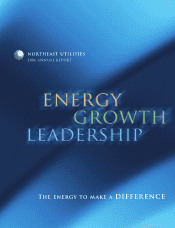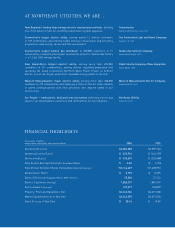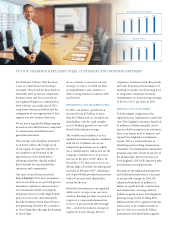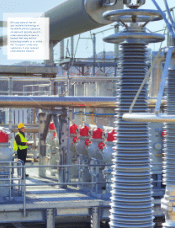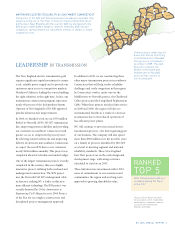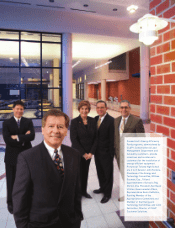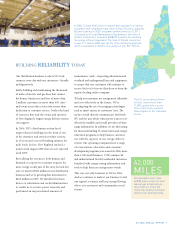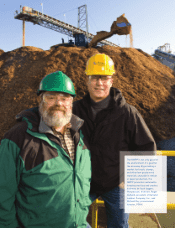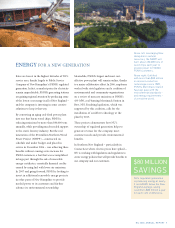Eversource 2006 Annual Report Download - page 9
Download and view the complete annual report
Please find page 9 of the 2006 Eversource annual report below. You can navigate through the pages in the report by either clicking on the pages listed below, or by using the keyword search tool below to find specific information within the annual report.
42,000
MILES
BUILDING RELIABILITY TODAY
Our distribution business is where NU truly
connects every day with our customers – literally
and figuratively.
Safely building and maintaining the thousands
of miles of electric and gas lines that connect
the homes, businesses and lives of more than
2millioncustomers in more than 450 cities
and towns across three states takes more than
dedication to customer service. It takes the kind
of resources that only the owner and operator
of New England’s largest energy delivery system
can support.
In2006, NU’s distribution system faced
unprecedented challenges in the form of one
of the stormiest and snowiest winter seasons
in 10 years and a record-breaking summer for
peak loads. In fact, New England reached a
peak load in August 2006 that was not expected
until 2009.
But rallying the resources, both human and
financial, to respond to customer requests for
more energy is only part of the story. In total last
year, we invested $360 million in our distribution
business and we’re growing that investment to
$445 million in 2007. We installed electronic
devices at substations and on distribution lines
to enable us toreroute power remotely and
performed an unprecedented amount of
maintenance work – inspecting substations and
overhead and underground lines and equipment,
to ensure that our customers will continue to
receive the level of service they deserve from the
region’s leading utility company.
Tohelp our customers use energy most efficiently
and cost-effectively in the future, NU is
investigating the use of emerging technologies
such as smart meters at customers’ sites. The
meters would directly communicate with both
NU and the useraboutwhen power is most cost-
effectively available and would provide real-time
usage information. In addition, we are advocating
forincreasedfunding ofconservation and energy
education programs to help balance customer
use with the capacity of our energy delivery
system. Our operating companies host a range
of conservation, education and economic
development programs year-round. In 2006, more
than 1,500 small business, 3,700 commercial
and industrial and 346,000 residential customers
benefited with energy-saving information and
tools to help them use energy more wisely.
This was everyday business at NU in 2006.
And we continue to make it our business to fuel
our region’s economy and keep energy flowing
where our customers and communities need
it most.
NU maintains more than
42,000 miles of electric and
natural gas infrastructure –
more than six times the
round trip distance between
Connecticut and California.
NU 2006 ANNUAL REPORT 7
In 2006, Tolland High School replaced and upgraded its lighting
equipment and completed many other energy-efficiency upgrades.
By participating in CEEF programs administered by CL&P’s
Conservation & Load Management Department, the town of
Tolland, Connecticut, received a $228,573 incentive for installing
the energy-efficient equipment. The town of Tolland is expected
to save 17.7 million KWH over the life of the installed equipment,
which is equivalent to lifetime cost savings of over $2.7 million.
The NU servicearea (shown
in blue) covers more than
11,000 square miles across
three states from southern
NewEngland tothe Canadian
border.

